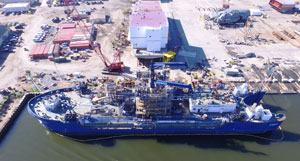Around this time last year, the tugboat building industry in the United States showed signs of a rebound. They weren’t exactly the “good old days,” but after some lean years the industry appeared heading in the right direction.
Then, shortly after the new year, a once-in-a-century pandemic brought economies around the world to a screeching halt. By mid-May, more than 95,000 Americans had died from COVID-19 and more than 36 million lost their jobs from the ensuing economic disruption.
Projections about the recovery yield wildly different timetables, ranging from six months to a year to five years or longer. But how soon the economy rebounds, both in the U.S. and in big industrial countries around the world, could determine how soon tugboat operators feel comfortable committing to major capital investments.
“My crystal ball is pretty murky right now,” said Mike Fitzpatrick, president of Robert Allan Ltd.
The company, based in Vancouver, British Columbia, had more than 20 tugboat design projects under development when the World Health Organization declared a pandemic in mid-March. Two months later, all but three projects were still proceeding. “This suggests to me that our owner and shipyard clients think, or at least are betting, that the market will recover sooner rather than later,” Fitzpatrick said.
 |
|
Bollinger Shipyards completed the Alaska-class ATB Aveogan/Oliver Leavitt for Crowley Maritime this spring during the COVID-19 pandemic. |
|
Crowley Maritime |
Not surprisingly, new business for the firm slowed dramatically during March and April when the pandemic raged across Europe, North America and parts of Asia. “We typically sign six or seven new projects every month, whereas in the past six weeks we have only contracted one new project,” Fitzpatrick noted. “That said, we have seen new inquiries pick up in the past couple of weeks and I believe we will sign closer to a typical number of new projects in May.”
Robert Allan Ltd. is an international company with clients in major shipping hubs around the world. That global reach could provide a softer landing in hard times. Yet in the U.S., where the economy effectively shut down for six to eight weeks, there was still some new activity during the depths of the virus-related doldrums.
Kurt Redd, chief executive of Diversified Marine in Portland, Ore., said he has received multiple inquiries during the pandemic. He signed a contract for a new tugboat this spring and has had discussions with another about building a 100-ton bollard pull tugboat.
“I don’t see the market as stopping by any means,” Redd said in a recent phone interview. “It is still moving forward. The companies that are building vessels are going to continue with those programs.
“The marine market is an interesting market,” he added. “Ships need to dock and things need to move, so I believe once it rebounds it will go back to how it was.”
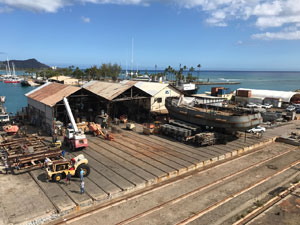 |
|
P&R Water Taxi has built more than a dozen tugboats at its Kewalo Shipyard in Honolulu. Railroad tracks are used to maneuver the vessels into position before launch. |
|
P&R Water Taxi |
That might not be particularly reassuring for some shipyard managers. New tug and towboat construction has slowed in recent years. The lingering effect of the building boom that preceded EPA Tier 4 emissions rules is one key factor. Operators in many cases sped up construction plans to avoid higher costs associated with building to the new EPA standards.
The persistent slowdown in the Gulf of Mexico oil patch is another factor, eliminating demand for offshore supply boats and other support vessels that kept many shipyards humming. More yards are competing for tugboat contracts these days, creating thinner and thinner margins. Coast Guard Subchapter M rules also have raised construction costs on top of increases associated with Tier 4.
“We went from building three boats a year to two boats a year,” Redd said of the pre-COVID market. “I am not going to say it hasn’t slowed some.”
During a downturn, some companies hunker down and reduce spending to ride out the storm. Others see a time to invest when the market is softer. Barring a rapid economic rebound, the trajectory of the tugboat sector over the next year or so will likely depend on how many companies decide to invest, and how many stay on the sidelines.
Building during a pandemic
Even as the pandemic raged through the U.S. this spring, shipyards in some of the hardest-hit states continued building vessels. States largely determined these industries were “essential,” meaning workers could remain on the job. Bollinger Shipyards in Amelia, La., completed Crowley Maritime’s new articulated tug-barge (ATB) Aveogan/Oliver Leavitt during the height of the pandemic.
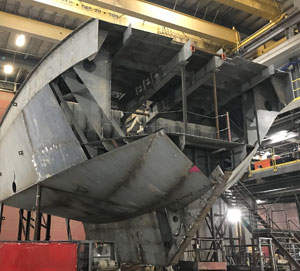 |
|
The lead boat in Moran Towing’s new class of ship-assist tugs coming together earlier this year at Washburn & Doughty. |
|
Moran Towing |
Chris Remont, Bollinger’s executive vice president for new construction programs, said employees focused on safety and quality while taking steps to protect themselves, their peers and customer representatives in the shipyard from COVID-19.
“We were able to overcome any vendor-related issues and delays while still maintaining focus on delivering the tug,” he said in an email. “We were, and still are, keenly aware of cleanliness and hygiene, and keeping ourselves, our workspaces and our surroundings clean and sanitized.”
Washburn & Doughty in East Boothbay, Maine; Nichols Brothers Boat Builders in Freeland, Wash.; Diversified in Portland; Great Lakes Shipyard in Cleveland; and Kewalo Shipyard in Honolulu are among the yards that delivered tugs during the pandemic. Western Towboat of Seattle completed final outfitting on its new harbor tug Mariner during the outbreak that hit the city early and hard.
Western implemented new protocols early in the pandemic to keep its tug crews safe, including a questionnaire about personal health and any recent contacts with sick people. Capt. Russell Shrewsbury, a Western vice president, said the same rules also went into effect for the company’s shipyard, which built Mariner and maintains the company’s tug fleet.
One new procedure requires the tugs to be empty of crew before repairs start. Shipyard workers also must notify vessel captains about the nature of the planned repair work, when it would take place and how long the work would take, Shrewsbury said. “As far as our other work in the shipyard goes, most of the time guys are staying a reasonable distance away from each other during the day unless absolutely needed,” he said.
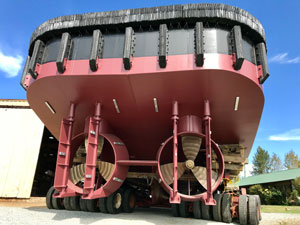 |
|
Sylte Shipyard in British Columbia built the 60-foot Gemini Warrior for Gemini Marine Services. |
|
Gemini Marine |
Similar trends define tugboat market
Tugboat operators working in major U.S. ports have spent the past few years adding more powerful vessels with higher bollard pull. This year was no different. Companies on all three coasts took delivery of new 80- and 90-ton bollard pull tugboats built to handle the bigger containerships and tankers calling on U.S. ports.
Foss Maritime, for instance, is building four new 90-ton bollard pull tugboats at Nichols Brothers Boat Builders, all of which likely will be assigned to busy California ports. Meanwhile, operators on the East Coast and Gulf of Mexico also are bulking up their fleets to safely handle bigger boxships.
Suderman & Young Towing and Bay-Houston Towing are each building five new ship-assist tugboats designed with enhanced high-speed escort capabilities. And McAllister Towing and Transportation, one of the more prolific builders over the past five years, added two new 90-ton tugs within eight months to solidify fleets in Charleston, S.C., and Port Everglades, Fla.
“The Eileen McAllister was constructed specifically to meet the needs of handling the ever-increasing size of vessels calling into Port Everglades,” said Capt. Chuck Runnion, vice president and general manager of McAllister’s Port Everglades office.
The push toward 90 tons within a 90- or 100-foot hull has been made possible thanks largely to new designs and new engines. It also could signal the upper end of what’s cost-effective and what’s necessary for typical ship-assist and escort work in most U.S. harbors.
In a late November interview, John Parrott, then-president and chief executive of Foss Maritime, suggested the 90-ton threshold could be the ceiling, at least in the near term. “A 90-ton tug is a lot of horsepower. One of these tugs will go on some of these very large ships, and in the whole evolution, they are using a very small percentage of all that horsepower,” he said.
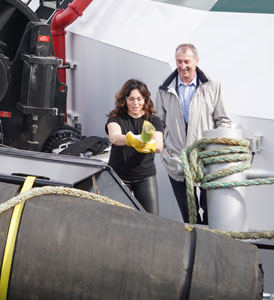 |
|
Jamie Ann Goldberg christened her namesake tugboat, Foss Maritime’s Jamie Ann, in late February at Nichols Brothers Boat Builders in Freeland, Wash. Shipyard CEO Gavin Higgins watched from behind. |
|
Casey Conley |
Tug projects on the horizon
Moran Towing, which has at least 18 tugboats with 6,000 or more horsepower operating along the East and Gulf coasts, has dialed back the horsepower for its new tugboat series under construction at Washburn & Doughty. The 5,100-hp tugs, the first of which is scheduled for delivery this summer, will have roughly 70 tons of bollard pull.
Late last year, Seabulk awarded a contract to Master Boat Builders of Bayou La Batre, Ala., for four new harbor tugs with 80 metric tons of bollard pull. Two tugs will feature the Advanced Rotortug design, while the others will have diesel-electric hybrid propulsion. Deliveries are expected starting in mid-2021.
Dakota Creek Industries in Anacortes, Wash., is moving forward with a new series of 90-foot tugboats designed by Robert Allan Ltd. for the U.S. Navy. Farther south in Tacoma, Modutech Marine is building two 63-foot z-drive tugs for the Navy based on Robert Allan Ltd.’s RAscal design.
Reinauer Transportation, Crowley Maritime and Quality Liquefied Natural Gas Transport (Q-LNG) are among the companies building new ATBs scheduled for delivery within the next year. Crowley’s 55,000-barrel unit will be built to ABS ice-class and IMO Polar Code standards for work in Alaska.

